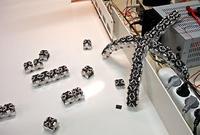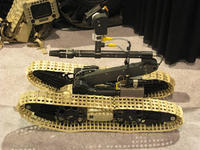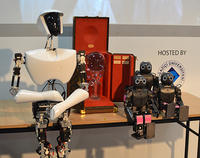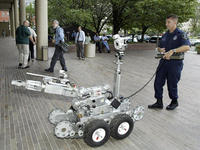-
New first response, military tool: surveillance insects

Micro air vehicles (MAVs) are tiny, insect-size UAVs used for search-and-rescue operations, surveillance, monitoring of hazardous environments, and detection of explosives; University of Michigan researchers had an idea: rather than build insect-size UAVs, why not use the insects themselves to fly these missions?
-
-
Enhancing communication of swarming robots

With the help of computer simulations and prototypes, researchers are striving to enhance the communication in human and multi-robot interactions
-
-
Micro Unmanned Ground Vehicle helps soldiers, first responders

Weighing just over ten pounds, Dragon Runner 10 (DR10) is small enough to carry in an assault pack and rugged enough to throw into buildings and hostile environments; the DR10 has multiple sensor and payload options, and thus is suitable for reconnaissance and surveillance missions to support small military units, patrols, and first responder teams
-
-
Self-assembled "micro-robots" designed
Tiny micro-robots — just half a millimeter wide — assemble themselves into star shapes when an alternating magnetic field is applied; the robots can pick up, transport, and put down other non-magnetic particles — potentially enabling fabrication of precisely designed functional materials in ways not currently possible
-
-
Research inspires robotics design for medicine, military
A pathogen that attacks the small intestines of humans and animals is serving as the inspiration for developing robots that can fight disease and aid in military operations; ror 250 years, scientists have tried to understand how the microorganism is able to attach to a multitude of surfaces and swim in harsh environments — enabling it to infect many kinds of species while most parasites have specific hosts
-
-
Tiny flying machines revolutionize surveillance work
Tiny aerial vehicles are being developed with innovative flapping wings based on those of real-life insects; incorporating micro-cameras, these revolutionary insect-size vehicles will be suitable for many different purposes ranging from helping in emergency situations considered too dangerous for people to enter, to covert military surveillance missions
-
-
Virginia Tech team dominates robot soccer World Cup competition

The Virginia Tech team dominated the international robot soccer competition known as RoboCup this past weekend, winning the Louis Vuitton Humanoid Cup, the competition’s version of the World Cup; the team also dominated with First Place in both the Adult Size class with the 5-foot humanoid robot CHARLI-2 and the Kid Size class with the miniature humanoid-robot DARwIn-OP
-
-
Roving robot can rescue people, detonate bombs
Northeastern University student-researchers have created a roving robot that can locate and rescue victims of natural disasters or participate in military missions that are too dangerous for soldiers; students created a complex algorithm that would enable the robot to locate people — or even bombs that are detonated through mobile phones
-
-
Tiltable-head robots adept at navigating disaster debris

Search and rescue missions have made the headlines in the last eighteen months, following the earthquakes in Haiti and Chile, the floods in Pakistan and New Zealand, and the tsunami in Japan; machines able to navigate through complex dirt and rubble environments could have helped rescuers after these natural disasters, but building such machines is challenging; Georgia Tech researchers have now built a robot that can penetrate and “swim” through granular material
-
-
Search-and-rescue robot operators get better with practice
Urban search and rescue (USAR) task forces are essential for locating, stabilizing, and extricating people who become trapped in confined spaces following a catastrophic event; sometimes the search area is too unstable for a live rescue team, so rescuers have turned to robots carrying video cameras; trouble is, research shows that more often than not, the human beings who remotely operate the robots have a view of their robot-control skills which is at variance with reality, causing robots to get stuck
-
-
Student aero-design competition to be held next week
The Aero Design competition, to be held at the end of the month, is intended to provide undergraduate and graduate engineering students with a real-life engineering challenge; the organizers say the competition has been designed to provide exposure to the kinds of situations that engineers face in their real-life work environment; students will find themselves performing trade studies and making compromises to arrive at a design solution that will optimally meet the mission requirements while still conforming to the configuration limitations
-
-
U.S. military robot to help detect radiation at Fukushima
The modified a military robot to navigate around Fukushima plant and produce a color-coded map of radiation levels; the robot includes a chemical, biological, radiological, nuclear, and explosive detection kit that can identify more than 7,500 environmental hazards, including toxic industrial chemicals and volatile gases; it also has temperature and air quality indicators and night vision, and it can sense sounds up to 1,000 meters away; the robot joins other pieces of specialized equipment, donated by QineticQ to help Japan deal with the crisis
-
-
High School students build Florida police a robot
In Rockledge, Florida, the local police department just purchased a new remote controlled robot that is equipped with a video camera, night vision, a gas canister launcher; rather than spending hundreds of thousands of dollars to purchase the robot from a defense company, the Rockledge police department turned to local high school students; the robot can handle any terrain, launch grenades, and is strong enough to drag a person; it is also outfitted with a speaker and a microphone to enable two way communications in addition to a police throw phone that can be deployed during hostage negotiations; the robot cost $6,000 whereas similar professionally made robot would have cost more than $100,000
-
-
Lockheed developing autonomous and covert rover
A surveillance robot aims to operate around humans without being detected by them; the machine uses a laser scanner to builds a 3D computer model of its surroundings and uses a set of acoustic sensors to distinguish the proximity and direction of footsteps
-
-
First response, law enforcement ground robot market to grow

The current market for first responder and law enforcement ground robots is estimated at $203 million; just-published research says that the market is poised for a significant growth; first responder robots cost about $50,000 and up, which is the cost of a person for one year; the challenge for vendors is thus to find applications where the robot is used 24x7 365 days per year
-
- All
- Regional
- Water
- Biometrics
- Borders/Immig
- Business
- Cybersecurity
- Detection
- Disasters
- Government
- Infrastructure
- International
- Public health
- Public Safety
- Communication interoperabillity
- Emergency services
- Emergency medical services
- Fire
- First response
- IEDs
- Law Enforcement
- Law Enforcement Technology
- Military technology
- Nonlethal weapons
- Nuclear weapons
- Personal protection equipment
- Police
- Notification /alert systems
- Situational awareness
- Weapons systems
- Sci-Tech
- Sector Reports
- Surveillance
- Transportation
Advertising & Marketing: advertise@newswirepubs.com
Editorial: editor@newswirepubs.com
General: info@newswirepubs.com
2010-2011 © News Wire Publications, LLC News Wire Publications, LLC
220 Old Country Road | Suite 200 | Mineola | New York | 11501
Permissions and Policies
Editorial: editor@newswirepubs.com
General: info@newswirepubs.com
2010-2011 © News Wire Publications, LLC News Wire Publications, LLC
220 Old Country Road | Suite 200 | Mineola | New York | 11501
Permissions and Policies
